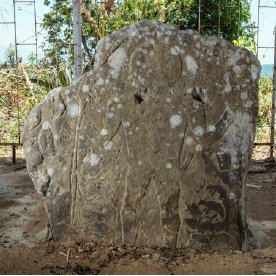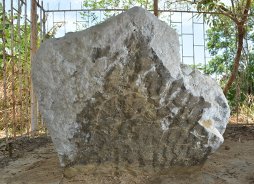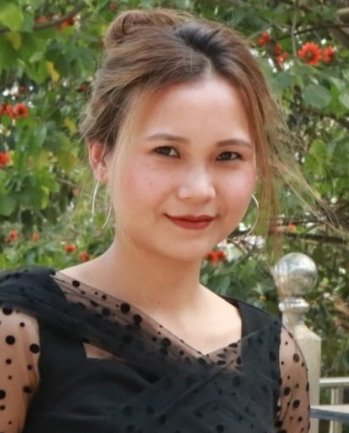— Lalhunkima
Research Scholar, Dept. of Sculpture, Rabindra Bharati University
Abstract :
Saizahawla, a legend of the past, who is considered to be one of the strongest men among the Mizos, left behind an artwork which is unique in its executional process. This paper expounds the validity of this artwork as a self-portrait. Archaeologists and historians have been on action in researching rock arts of Mizoram and progress have been made in excavating and interpreting. Visual art studies play an imperative role in filling the lacuna within the empiricist studies: aesthetic value, representational style, and the concept behind the execution of this rock art are the focus of this paper.
Key word: Portrait, visual language, megalith and symbolic.
“Three million years ago someone recognized a face in this pebble and brought it to a rock shelter for safekeeping, but the stone is not an artwork because it was neither manufactured nor modified.” (Kleiner 12)
Art, its definition needs a radical examination to analyse it and conclusion drawn on its definition can be extremely diverse. What and when is art? Is a question often argued. The above statement by Kleiner S. Fred is a pointer for this paper to have a notion of what not is an art, and a hint of what art can be. As focus is stressed on an aspect, portrait, which is also a hot topic in visual art in terms of its appropriation. Simply put, portraits are art works, intentionally made of living or once living people by artists, in variety of media, and for an audience. (Brilliant 12) The art form, portraiture, is incredibly ancient, evident is found as far in time to ancient Egypt, which can be dated back to 5000 years. (Hall 20) Though portraiture is a common phenomenon in visual art of the ancient, bona fide self-portrait is in a state of rarity.
Self-portrait is the magical fifth element, first among equals with the four traditional genres (histories, portrait, land- scape and still life). Depending on who you talk to, it is an inspiring symbol of artistic freedom or a symptom of what has been dubbed ‘ the culture of narcissism.’ Few are indif- ferent to self-portraits, and the claims that are made for them (Hall 12).
The word ‘self’, as in ‘self-portrait’, in Mizo language, ‘Mahni’, cannot solely be considered as narcissistic expression, but excessive used in verbal expression, through its first-person pronoun, ‘kei’ or ‘keimah’, is often a language considered exhibiting narcissist’s element. The above statement by James Hall reads, self-portrait as the culture of narcissism which is among the concept of executing self-portrait but not necessarily always among its inherence characteristics. Though self-awareness and being hero was highly revered in early Mizo society, selfishness cannot occupy vital space in the heart of the people. The term narcissist might not be a key dominant value for self portrait of Saizahawla, as among Mizo’s value systems the dominant praxis was a social institution called tlawmngaihna: an ideal of life in which a man cannot be outdone in doing good to others. In general, it means ‘self-sacrifice for other’, (Lalbiakmawia 102) and the self-sacrifice sometime demands life itself. (R.L.Thanmawia 15) In this study, the inference is that self-portrait is an artwork which is executed by the artist to represents himself and the consideration of “symbol of artistic freedom” is discussed in the main body of this paper. Thus, taking into consideration, the idea of tlawmngaihna, it directly counter argued the existence of narcissistic element present in the process of making self-portrait in the case of this study.
Intriguingly, at the top of Seling Lawibual hill, stood an undressed stone monument, decorated with visual language of the past Mizo tribes, known as, Saizahawla lungphun (Fig. 1). This can be one, identified as self-portrait among Mizoram rock art. Though petroglyphic icons and images found in Mizoram rock arts have similarities and apart from the depth of carvings and size of rocks, differentiating it with only the stylistic features is a hustle.

Classifying this artwork in the nomenclature of archaeology, it can be termed, ’menhir’, which in common language: a single standing stone. Prominent historians in Mizoram, B.Lalthangliana, could classify it based on the visual language and technique or depth of carving (Lalthangliana 488-489) and Malsawmliana, classified it according to its typology (Standing stones, table stone or stone seats supported by three smaller stone, stone platforms carrying a stone upright on top and cairns or a heap of stones) and functionality ( memorial stone and commemorative stone).(Malsawmliana14-22) It is uncommon to the point of rarity that self-portraiture even exists as a form of representation in Mizoram rock art. Among the early Mizos, erecting stone served as memorial to the dead and is associated with achieving highly considered social status called “Thangchhuah”,1 and feasts of merit of the chiefs. Certain traits of Saizahawla qualify this phenomenon of erecting stone in his name and the factualization and the reason is discussed in the main body of this paper. Yet, the problem to consider is whether the identification of the image with the name associated, historically valid character and contextually and culturally valued properties, is acceptable to grant this, Saizahawla lungphun, a status, self-portrait.
Art Historian Richard Brilliant has taken the position that in portraiture possibilities of identification range far beyond the boundaries of mimetic description (Brilliant 17) which concertize the individual portrait and there can be an assumption that it represents and preserves the idea of a particular human being. While recognizing the symbolic importance of pictographs (and petroglyphs), it is also imperative to realize that the symbolism of the rock art may involve much more than the iconography. (Whitley 28) Contrary to this, in contemporary language(s), when the word portrait is enchanted, naturalism pops up and its tendency of assumption is aggressive. Trying to place this artwork in the timeline far reach from modernity is not accurate as Saizahawla experienced the time after pre-history, and writing system was already introduced towards the end of his life.
Biography of Saizahawla.
Saizahawla was born in the year, which is approximated, 1858. (Lalthangliang 537) He belongs to Hmar tribe. His mother is Tuahpuii and father, Chalpuia. Later in his life, he migrated from Khawruhlian village to Seling village. He is a father to two sons and two daughters: Thanzama, Thanseii, Laleni and Thansanga. His great grandson, Vanlalchaka, the grandson of Laleni, still living in Saitual, stated that his great grandfather, Saizahawla, might have more descendants from different mothers, as in those days he travelled a lot, and his fame would have attracted females wherever he travelled. (Vanlalchaka) At Seling village, he was poisoned by Hmar tribe, in the year, which is approximated, 1910.2 His body was laid in Seling Tlang, the vicinity from his Lungphun.
Regarding the Physical features of Saizahawla, B. Lalthangliang, in his book, Zoram encyclopaedia represents a short description: In his adulthood, he is on the taller side in height, he has prominent forehead, deep eye socket, well build muscle, broad shoulder, big triceps, flat stomach with broad waist. (Lalthangliana 537) “Bem” is what define his physical structure in Mizo dialect.
Mizoram is endowed with pre-historical megaliths and the tradition of erecting stone monument is still a trend till date, now, mostly for the memory of the dead as tombstone and occasionally for representing important events and valued assets. Back then, megalithic culture served different purposes, mentioned above, it was for the memory of the death and to represent the celebrated performance merit of villages heroes which is highly regarded and termed as ‘thangchhuah pa’ and feast of merit of the chief. (Malsawmliana 37) Art and culture Department , Mizoram and Archaeological survey of India have been on the process of excavating and new findings are recorded sporadically.
In Northern regions of Mizoram there are numbers of megaliths which have the same stylistic features in comparison with megaliths from other parts of Mizoram i.e., those that are found in Lianpui, Vangchhia and North Vanlaiphai etc. Among the megaliths is Saizahawla lung, erected by Saizahawla himself, now protected by Art and Culture department, Mizoram. The locality claims that he carried the stone up to the mountain peak from Zotui riverbed all by himself. Till today, his strength and sense of humor are still a delicacy in the local chatting. He was Bawlpu, a priest, whose duty was to heal sick and black smith in profession, with a pinch of humor in his character. He was a lover of kids and sometime, only kids could convince him in doing certain tasks, an important task to heal the sick with sacrificial ritual. What defines him apart from his strength is his bravery and honesty.
The era before Christian missionaries set foot in Mizoram, knowledge was transferred in oral process and making pictures are among the means of expressing the language consisting of different values. Value system was among the many reasons that ignited the inception of inscribing form in the hearts of the early Mizo people. Among the Mizo value, as reflected in oral tradition written in the book, Mizo Values by R.L.Thanmawia, which can be associated with Saizahawla are, bravery, hunter, tlawmngaihna and strong man(10-17). He was also known for head hunting. When he was in Khawruhlian village, one of the villager was attacked by Hmar enemy and was killed. To avenge him, he solely ventured out to the enemy’s village and then to make peace with the dead he killed one of the enemy’s villagers and brought back his head to his village. For this act of bravery, the chief of the village, gave him an honourable position in the village. He was even awarded by the chief to have highest authority in the village and forest area. Saizahawla humorized his authority, by constructing his house leaning on the chief’s pole called ‘seluphan’, which is a valuable sacrificial post and right at the center of the street, which clearly shows his high sense of humor. Pawibawiha’s village used to be at peace because of him. (Chhangte and Biaktluanga 216)
Strength wise, Saizahawla, had enough, to stand against wild mithun. Lal Pawibawia, a Chief of Khawruhlian, wanting to prove the magnitude of Saizahawla’s strength, organized an event where he requested him to have a fight with his wild mithun. At the beginning of the fight, it seemed the mithun pushed him back, but once he soaked up his strength, he could reverse the momentum and pushed the mithun back till it gave up; mithun which is also a metaphorical representation of strength was subdued. Another instance, in the year 1901, when Edward VII was crowned king of Great Britain, the Lushai hills superintendent invited 70 Mizo chiefs and he organized a sport for the celebration, where Punjabi workers and Mizo chiefs were made to play tug of war: Among the Punjabi workers was also a famous man known for his strength, his was even called “Vai3 Saizahawla”. Those that viewed the tug of war claimed that Saizahawla would be able to defeat the opponent team all by himself. This quality, strength, is the identity, he sculpted in the heart of the one who acknowledge his existence.
One character that highly represents him was, the ability to subdue his fear: courage. There was an instant when villagers had to kill a tiger who killed Darhuma, member of the council of elders. He was strongly determined to kill the tiger. Sharpening his knife, took his gun and went out to ambush the tiger. He said that even if he missed the only shot that he had, he would be able to stop it with his knife, somehow the tiger did not turn up. Saizahawla was a hunter but not much record was made related to hunting but inversely the petroglyphs on the megalith hint that he had killed valuable animals like mithuns and deers. He was even known to achieve the title “Thangchhuah pa” in the category “Ram Lama Thangchhuah”. In fact, traits which a hunter mostly possess was bravery and strength, which is an essential quality of hunters.
Saizahawla was also famously known for his honesty: once he ventured out to the north with his friends, Khawzathanga and Ekchhetea , they reached Perhzawl village. Alone, he went to the village’s Zawlbuk and his friends were waiting for him outside the village. At night, he disguised himself as a member of the village youth and slept among them and when everyone fell asleep, he got up and stole three guns and poured water inside the barrel of the rest of the remaining guns. As they returned, his friends made a plot, trying to cheat the chief, to make him think that they had killed enemies and since the journey was too long, they could not bring their enemies’ heads home. For their achievement they plan to make the aspiring chief to organize muallam, which is one of the highly regarded dancing ceremony to glorify warriors, who returned home with enemies head. When it was time for the ceremony to be performed, Saizahawla declined the invitation and declared that such an action was not performed by them; he chose to remain in the truth.
Portraits have always been more than just a record. They have been used to show the power, importance, virtue, beauty, wealth, taste, learning or other qualities of the sitter. ( Tate ) Here sitter may not be the defining term for the one portrait, yet it can be used as a metaphor of the one that is portrayed. The degree of defining portraiture today and the era of Saizahawla can be miles apart, yet the idea of portraiture can still be the same as the concept of portrait remains more constant as we examine the reason behind the erection of the stone. Through his self-portrait, we could relate with him in a way that define him as a warrior, hunter, and an abled person in the society he performed. The self-portrait become the reminder of his existence and ability. In regard to verisimilitude representation, there is not much to articulate, yet in the stone is engraved his ability and achievement that he had accomplished.
Composition and representation:
Composition on the megalith can be divided into four parts, front, back and both the sides, yet, considering it as one whole composition including all the four sides, is the key to define this artwork as one masterpiece. The dimension of the stone is 39 inch in height, 39 inch in width and 7.5 inch in its thickness. The composition consists of a male figure standing at the centre which is the main subject of the artwork. He holds a spear with his right hand and an unidentified object with his left hand. Neither customs as such is worn by the human figure nor a head gear. On his waist a special knife called ‘milulak chem’, is carved, which is only used for removing head from the body after subduing enemy. Another knife handle is also represented along with the ‘milulak chem’. His facial characteristic is subtly defined.
Signature elements in the representational style of Mizoram rock art which can be considered as repeated artistic decision (Heyd 279) through times are found: a single human figure with front facing torso and head, feet, and arms in profile view. In archaeology, a singular artefact can be viewed as an object whole with its own particular attributes. These archaeological object wholes, however, are also contextually enfolded within the larger whole of the archaeological setting. (Wenger 35) Figures of mithuns, popularly represented animal in Mizoram rock art are placed randomly. At the frontal plane, the main subject, human figure is placed at the centre, and he is surrounded by animal figures. There is no natural orientation but the placement of the human figure, which is, at the centre of the composition, is popular in Mizoram rock art.
Observing the self portrait of Saizahawla, the idea of verisimilitude in art is not the main highlight, realistically represented but not up to the level of naturalistic, rather it contains the value and idea of the one portrayed. Interpretation of Mizo valued animals like deer and mithun is depicted. A box like image is below the left hand, which could be a representation of a shield and below the right hand there is an unidentified tear drop shape object. At the right side of the stone, (Fig.2) the composition holds three images of mithuns in a regular pattern, vertically arranged and on the left, (Fig.3) another three mithuns, placed vertically with variable sizes.

Composition at the back side (Fig.4) consists of one big mithun surrounded by three others and one deer, which are smaller in size. Distinction can be made only by the horns of the animals; bodies of the animals’ figures cannot be much differentiated. Henry Zerner propositioned that physical likeness is not a necessary condition of the portrait; that, rather than are retinal comparison between the image and the model, cognitive recognition constitutes a sufficient test. (Winter 267) Through careful analysis of this rock art, the images are more inclined to semiotic than mimetic, which is a widely analytical tool used in prehistoric rock art research: instead of representing the likeness of himself, his quality, ability, and achievement was expressed through this art, which is by any means, symbolic in its representation.

Material and technique
Technically Saizahawla was supposed to be exceptionally good in craft as he was a black smith. Black smithy played an important role in making weapons and implements for war and hunting, as well as for agricultural and domestic use. (Zochhunga 23-38) knives, chisel, spear head etc. were supposed to be smithed by blacksmith. So, in term of craftsmanship, he can be considered skilful. Sedimentary rock is used for the Megalith which is extracted from riverbed. The quality of the material contributes to the continuity of the artwork in time. Looking at the composition and the petroglyph, it can clearly be identified that the stone is fully intact, which is suggested by the spearhead, the tip of which is curved outside the corner edge of the front plane and fall into the top right side of the rock. There is no specific directionality when placing images in the composition, the central figure, human, though, is the first one to be executed, suggested by the cramping of the other images which surround him.
Conclusion:
This object of art, self portrait of Saizahawla, exhibits a salient value of the existing societal being of Mizo of his era. The narrativity of the artwork and the inference that repeated artistic decision made during the execution provide a timelessness of the art and the appreciation of aesthetic value as well. On the other note, making of image though prejudice may not be as much available as modern day’s artist in terms of concept and context or even theory making. The freedom of expression he had acquired, not only in visual expression but also in his humours and way of life and the continuity he had handed down to the coming generation to acknowledge and experience his self-portrait through this monument is a great asset in the history of the art of Mizoram.
Notes
- Thangchhuah, is one the highest revered social status of the early Mizo, physically and spiritually, which transgress the physical dimension to the heavenly realm, as not only one was rewarded high status in the society in ones lifetime, it was believed that Thangchhuah pa would enter the better abode of dead called Pialral where he would enjoy eternal bliss and luxury. There are two types of thangchhuah: inlama Thangchhuah and ram lama Thangchhuah. For the former, one must kill certain prescribed animals and perform a series of feast called Ai for each animal killed and for the latter, one must perform a series of feasts for the whole villagers.
- Narratives about Saizahawla are taken from, K. Zawla, Mizo Pi Pute leh an thlahte chanchin, Revised & enlarged, Tribal Research Institute, 1985 and specific dates of his birth and death and details about his physical features are taken from B. Lalthangliang, Mizoram Encyclopedia, Published by Remkungi, 2003.
- ‘Vai’ is the term used to refer non-Mizo Indian.
Works cited
- Lalthanglian, B. Zoram Encyclopedia (Zoram Tinreng Bu). Published by Remkungi, Aizawl, 2003.
- Lalthangliana, B. India, Burma Leh Bangladesh-a Mizo Chanchin. published by Remkungi, 2nd edition, 2014.
- Lalbiakmawia, C. The Mizo Lifestyle [Mizote khawsak Dan]. Aizawl, Mizoram Publication Board, 2000.
- Whitley, David S. Introduction to rock art research. Kindle version, Routledge. 2nd edition.2016.
- Winter, Irine J. What/when is a portrait? Royal image of Ancient near east, Proceedings of the American philosophical soci ety, JSTOR, Vol-153, no 3, 2009.
- Hall , James. The Self Portrait, A Cultural History. ebook, Thames and Hudson, New York, 2014.
- S. Fred, Kleiner. Gardener Art Through Ages. A global history, Cengage learning, 2015.
- Chhangte, Lalchhanhima, and Biaktluanga. Pawibawia. Mizo Lal ropuite. Tribal Research Institute, Art and Culture Department, Arbee Publication, reprint 2018, 2nd edition,1996.
- Brilliant, Richard. Portraiture (Essays in art and culture). kindle version, Reaktion book, London, 1991.
- Wenger, Robert. Visual art, Archaeology and Gestalt. Leonardo, JSTOR, Vol-30, No-3, 1997
- Thanmawia, R.L. Mizo Values. Din Din Heaven, Aizawl, 2011.
- Heyd, Thomas. Rock “Art” and Art: Why Aesthetics Should Mat- ter, chapter 16, A companion to Rock Art, edited by, Jo Mc Donald and Peter Veth, 2012.
- Zochungnunga. Survey of Pre-colonial Mizo Economy,’ in Pialral : Historical Journal of Mizoram, Vol-v, Mizo History Association, 1995.
- Portrait. Tate, 4.4.2021, https://www.tate.org.uk/art/art-terms/p/ portrait.
- Presonal interview with Vanlalchaka on 17 March 2021.
Cite the original source:
Lalhunkima. “Megalithic Portrait: Study of Self-Portrait of Saizahawla.” Mizo Studies, X, no. 4, Dec. 2021, pp. 706–718.
Lalhunkima. “Megalithic Portrait: Study of Self-Portrait of Saizahawla.” Mizo Studies, X, no. 4, Dec. 2021, pp. 706–718.
![]()






